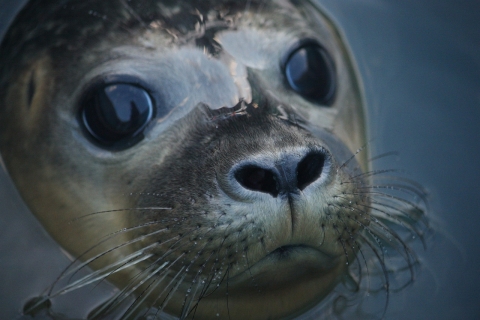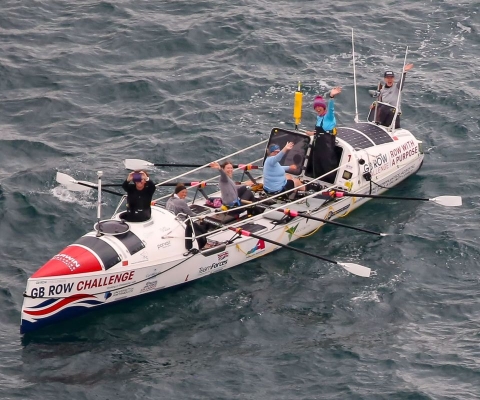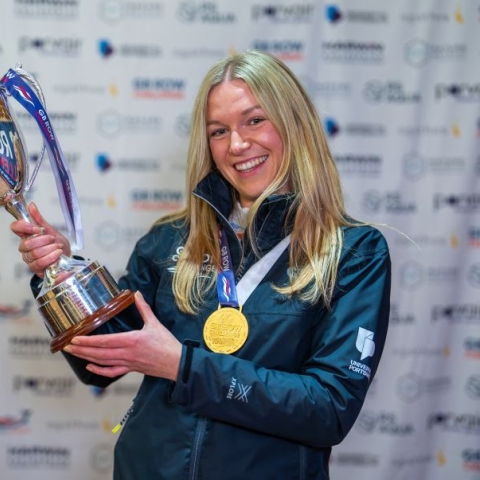

The report gives one of the most detailed baselines of British coastal biodiversity
14 May 2024
6 min read
The eDNA data found:
- Critically endangered species, such as the European eel
- Vulnerable species like Atlantic cod, haddock and the Atlantic puffin
- Fish such as wrasse, gobies and garfish
- Mammals, such as killer whales (orcas), seals, porpoises and dolphins
The biodiversity data collected by a team of rowers as they raced around Great Britain last year has been published in a new report.
The report gives one of the most detailed baselines of British coastal biodiversity for fish, mammals and birds using environmental DNA analysis.
The data was collected by a crew taking part in GB Row Challenge, a 2,000-mile rowing challenge around Britain’s rugged coastline, who set a new Guinness World Record for the fastest female team.
A key goal of GB Row Challenge is to provide one of the most detailed baselines of British coastal biodiversity over a four-year period. Last year, data collected by rowers detected 120 species across 66 environmental DNA samples. In 2022, only 82 species were found in 77 samples.
This improvement in detection is thanks to engineers from Harwin and Porvair Filtration Group who worked tirelessly to automate the method for sampling marine life.
Fay Couceiro, Professor of Environmental Pollution at the University of Portsmouth and lead scientist for GB Row Challenge, said: “Environmental DNA samples were collected using a manual method in 2022 - water was pushed through the filters by hand using a syringe. This was hard work for tired rowers, time-consuming and prone to human DNA contamination.
“Our engineering experts worked hard to devise an automatic pumping system positioned at the stern of the boat, which pumped seawater through filters twice a day. This not only lightened the workload on the rowers, but also significantly reduced the risk of human DNA interference.”

Team Ithaca rowing around Great Britain's coastline last year
Environmental DNA (eDNA) is genetic material shed by animals into their environment, which can include dead skin cells, mucous, saliva and faeces. This eDNA can be filtered out of the ocean by passing seawater through a fine mesh. This filter mesh is then sent to a laboratory for analysis.
The eDNA data found critically endangered species, such as the European eel, and vulnerable species like Atlantic cod, haddock and the Atlantic puffin. Fish such as wrasse, gobies and garfish, and mammals such as killer whales (orcas), seals, porpoises and dolphins were also detected.
Despite being amidst a global biodiversity crisis, there are some positive findings in the data. It shows that sandeels are present around the coastline, a species that can define an entire ecosystem.
Professor Couceiro explained: “Sandeels are a vital food supply for seabirds, marine mammals and larger fish, so their decline can have enormous repercussions for other marine species. In January 2024, the UK government announced a ban on industrial sandeel fishing in all Scottish waters and the English North Sea. It is hoped that we will be able to observe how this ban impacts the iconic species that feed on them in the coming year’s datasets.
By combining eDNA data with the temperature, microplastic and underwater noise data, also collected by GB Row Challenge rowers, it is hoped we’ll be able to determine current impacts of these parameters on biodiversity and UK coastal health.
Fay Couceiro, Professor of Environmental Pollution
“Environmental DNA is semi-quantitative and our dataset does not allow us to calculate how many individuals there were of each species we found. It can determine where species are found and how they move over time. This is important for fisheries and endangered species management. For example, GB Row data showed the Atlantic cod occupied very different regions of UK coastal waters between 2022 and 2023. The variations in water temperature between 2022 and 2023, as captured by GB Row Challenge data, may be one of the factors causing this change in distribution. Repeated datasets will allow us to monitor these kinds of interactions.
“By combining eDNA data with the temperature, microplastic and underwater noise data, also collected by GB Row Challenge rowers, it is hoped we’ll be able to determine current impacts of these parameters on biodiversity and UK coastal health.”
Dr Kat Bruce is a molecular ecologist and founder of NatureMetrics, a GB Row Challenge partner company which helps organisations measure and monitor biodiversity. She completed the GB Row Challenge in 2022 and is skippering a crew in this year’s race.
Dr Bruce said: “eDNA analysis has revolutionised ecological research and conservation efforts by providing a non-invasive and sensitive method for monitoring biodiversity in different ecosystems.
“Even after all these years it amazes me how much biodiversity we can detect in small volumes of water, and the way it lets us see how different species are distributed in the environment, from tiny gobies up to dolphins and seals.
“Even Scotland's resident killer whales showed up in the eDNA samples, suggesting the crew narrowly missed what would have been an exciting encounter!”
Click the link below to read the full report:
You might also like...
Record-breaking rowers honoured at GB Row Challenge awards
Team Ithaca, the crew who set a new Guinness World Record for the fastest female team to row around Great Britain, received their medals and cup at an awards ceremony on Saturday.
15 November 2023
4 min read

Ocean rowers set new world record for fastest female team around Great Britain
A team of six ocean rowers has set a new Guinness World Record for the fastest female team to complete the GB Row Challenge.
19 July 2023
6 min read

Rowing challenge to collect scientific data inspires local children
Pupils from Horndean Junior School spent an afternoon learning about how a non-stop rowing challenge can be used to collect vital scientific data.
7 July 2023
4 min read

